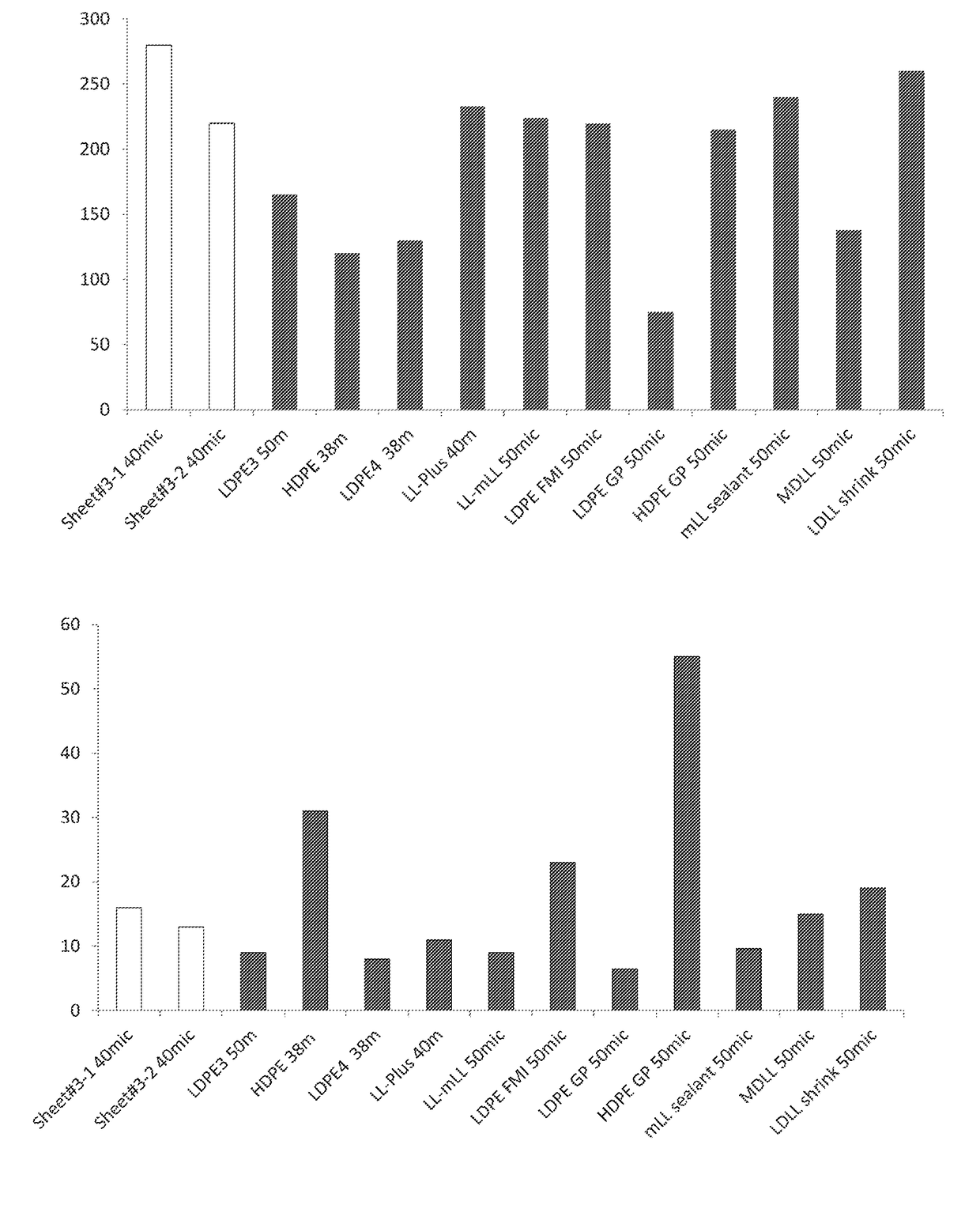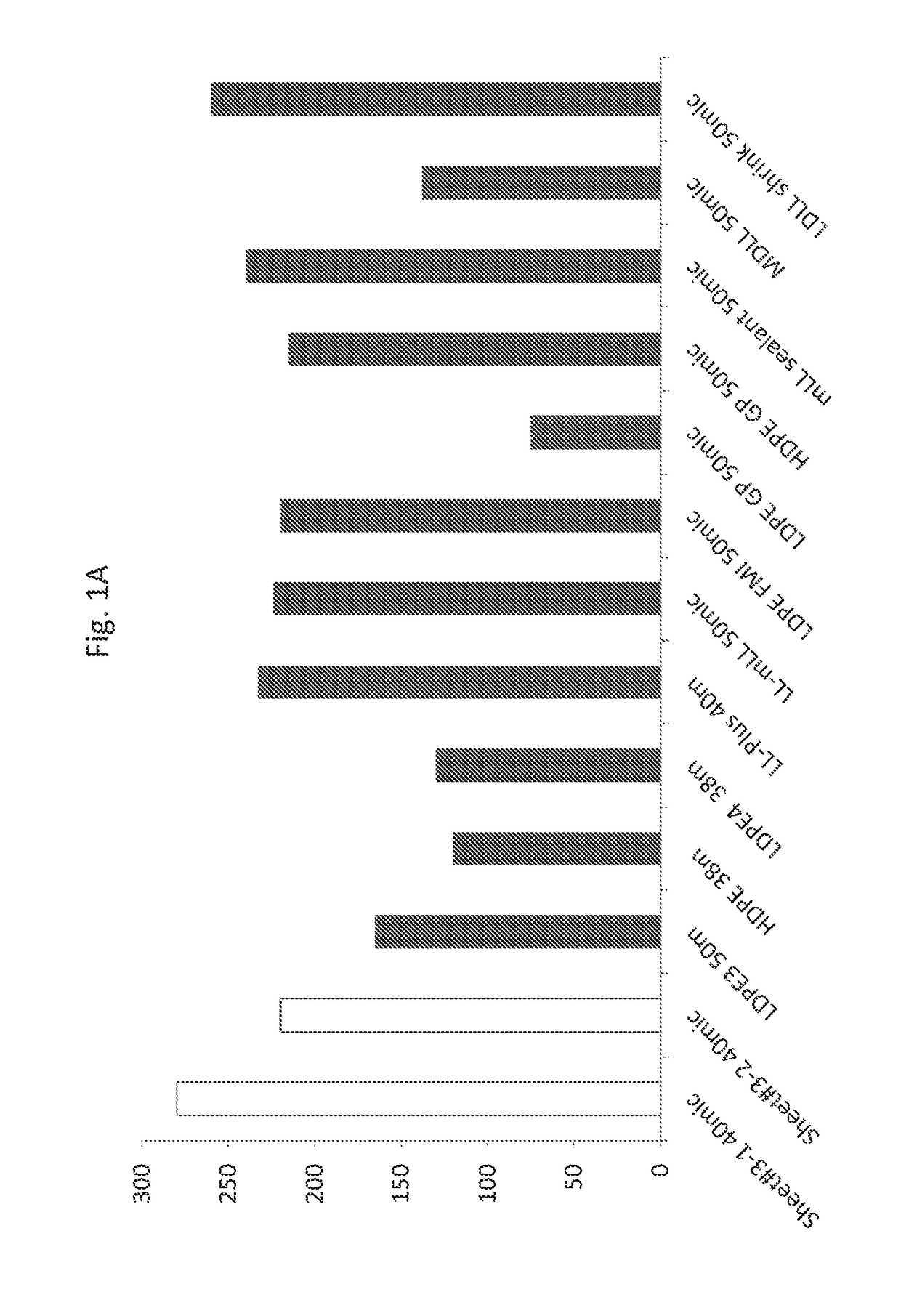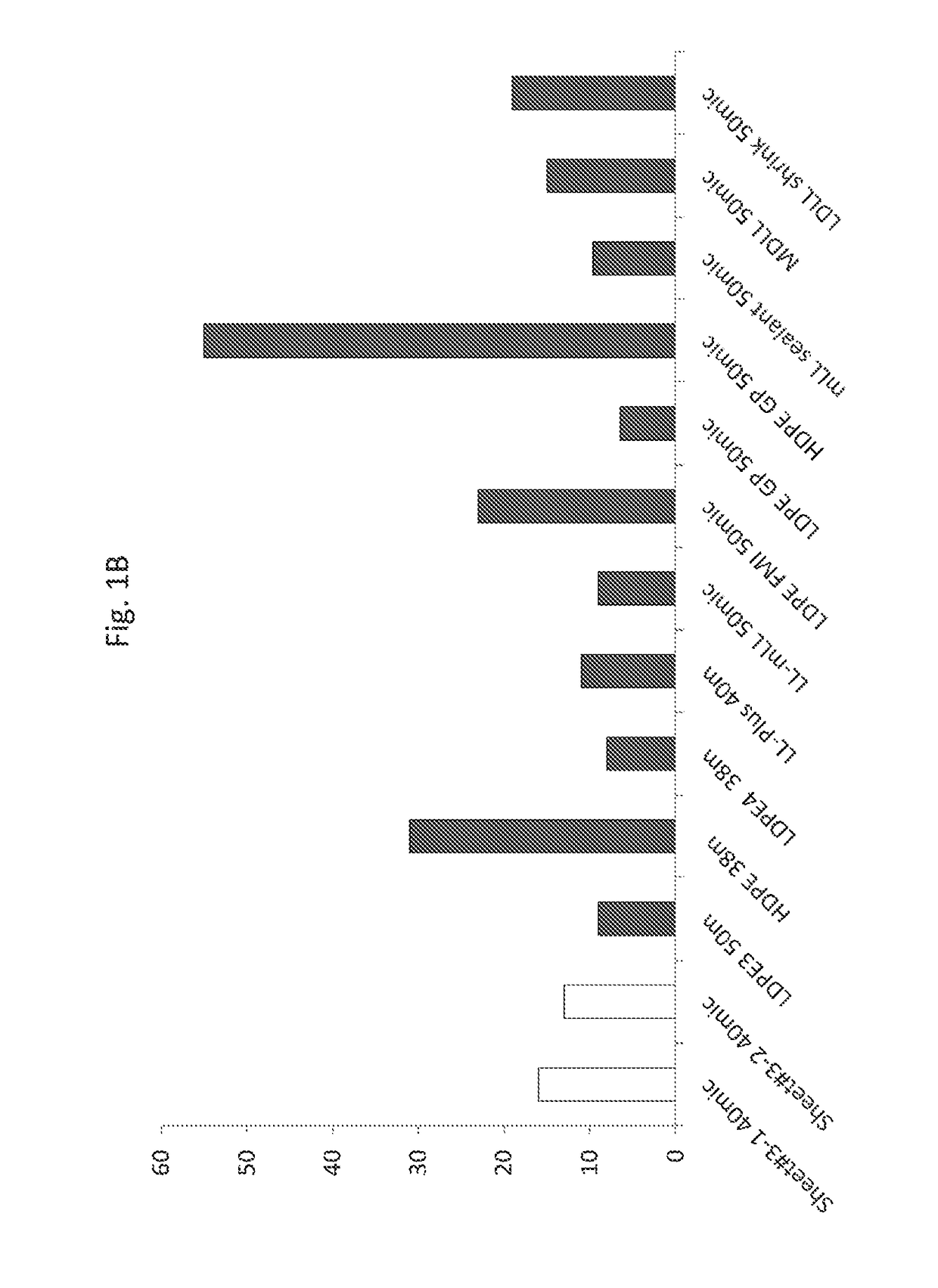Biodegradable sheets
a technology of biodegradable sheets and biodegradable sheets, applied in bio-packaging, sustainable manufacturing/processing, sustainable packaging industries, etc., can solve the problems of phb and pla, but are also quite rigid or even brittle, poor candidates when flexible sheets are desired, etc., to reduce water and/or oxygen permeability.
- Summary
- Abstract
- Description
- Claims
- Application Information
AI Technical Summary
Benefits of technology
Problems solved by technology
Method used
Image
Examples
example 1
Embodiments of Sheets and Laminates According to the Present Teachings
[0185]Specific embodiments of sheets and laminates according to the teachings are shown in Table 1 and Table 2, respectively, and described below:
TABLE 1FilmsThicknessThicknessThicknessSheet #Layer(μ)Layer(μ)Layer(μ)1PLA (60%):PCL10-30PBS 7-20(40%)2PBSA (75%):PLA10-15PBAT15-20PBSA (75%):PLA 5-10(25%)(25%)3PBSA (75%):PLA 5-15PBAT20-40PBSA 5-15(25%)4PBS10-25PBAT15-35PBS 5-205PBSA (75%):PLA10-25PHA15-40PBSA15-25(25%)6PBSA (75%):PLA10-25PHA15-40PBAT10-30(25%)7PBSA (75%):PLA10-25PBSA (75%):PLA15-40PBS10-25(25%)(25%)8PBSA (75%):PLA10-25PBSA (75%):PLA10-30PBS (56):PLA (19):PCL10-40(25%)(25%)(25%)9PLA (60%):PCL (40%) 5-15PBAT20-40PLA (60%):PCL (40%) 5-1510PLA 5-10PBS 7-20PBS 5-1011PLA-metallized15-50Cellulose-15-50PLA-Siox15-35metallized12PBS 5-20PLA (60%):PCL (40%)10-30PBSA10-2013PBS 5-20PLA (60%):PCL (40%)10-30PBS 5-1014PBSA (75%):PLA15-60PBSA (75%):PLA15-60(25%)(25%)15PBSA (85%):PLA15-60PBSA (85%):PLA15-60(15%)(15%)16P...
example 2
Properties of an Exemplary Sheet as Disclosed Herein
[0251]In order to define the physical properties of an exemplary biodegradable sheet as disclosed herein (sheet #3) of Table 1, several measurements were used.
[0252]Young's Modulus and UTS were measured using the ASTM D882-10 Standard Test Method for Tensile Properties of Thin Plastic Sheeting.
[0253]Haze was measured using the ASTM D1003-07e1 Standard Test Method for Haze and Luminous Transmittance of Transparent Plastics.
[0254]Impact was measured using the ASTM D1709 Standard Test Method for Impact Resistance of Plastic Film by the Free-Falling Dart.
[0255]Physical properties of the exemplary sheet were compared to those of a wide range of non-biodegradable, commercial polyethylene films which are commonly used in the packaging industry. Results are shown in FIG. 1.
[0256]As seen in FIGS. 1A-1D, the exemplary sheet according to the teachings disclosed herein was shown to have values of impact, haze, modulus and ultimate tensile stre...
example 3
o Generate Biodegradable Laminates with Coated Biodegradable Sheets
[0257]All of the multilayer sheets disclosed herein were about 15-120 microns thick. Aluminum metallization of some of the sheets disclosed herein below may be performed using methods known in the art. In some embodiments the metallization was carried out using aluminum under vacuum and low temperature metallization. As disclosed herein, Layer 1 is the layer in contact with the material, for example liquid, semi-solid or solid material.
[0258]Sheet #18: A three-layered biodegradable sheet consisting of about 16.7% w / w PLA, 83.3% w / w PBSA was prepared as follows:
A. Melt Extrusion Compounding Stage:
[0259]1. 50 gr PLA and 150 gr PBSA were dried overnight at a temperature of 50° C. under vacuum;
2. the dried polymers were dry blended and placed in a two screw PRISM compounder;
3. the polymers were melt extruded in the PRISM compounder set to the following profile:
i) temperature profile: 170-175-180-185-190° C. (the Die is s...
PUM
| Property | Measurement | Unit |
|---|---|---|
| thick | aaaaa | aaaaa |
| thick | aaaaa | aaaaa |
| thick | aaaaa | aaaaa |
Abstract
Description
Claims
Application Information
 Login to View More
Login to View More - R&D
- Intellectual Property
- Life Sciences
- Materials
- Tech Scout
- Unparalleled Data Quality
- Higher Quality Content
- 60% Fewer Hallucinations
Browse by: Latest US Patents, China's latest patents, Technical Efficacy Thesaurus, Application Domain, Technology Topic, Popular Technical Reports.
© 2025 PatSnap. All rights reserved.Legal|Privacy policy|Modern Slavery Act Transparency Statement|Sitemap|About US| Contact US: help@patsnap.com



